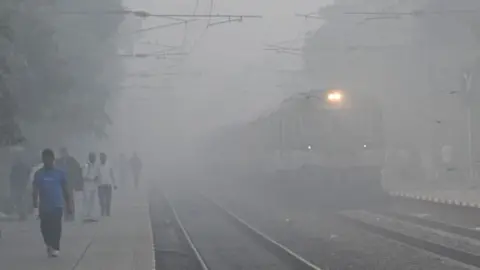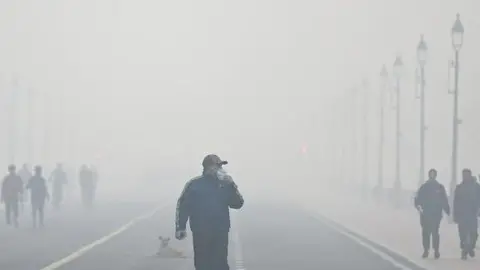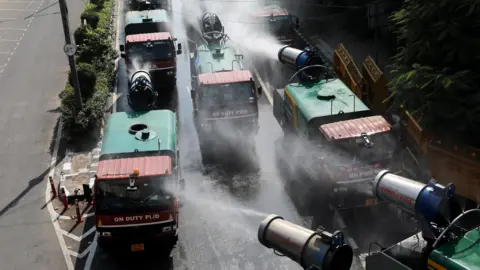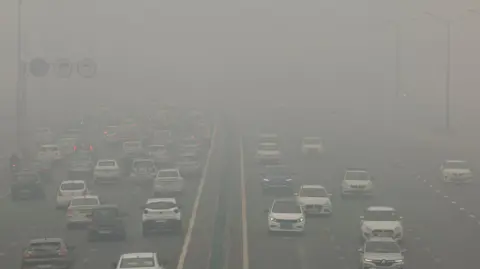Living in Indian capital is like watching a dystopian film again and again
 Getty Images
Getty ImagesWinter has arrived in Delhi, and with it comes a familiar sense of gloom. The sky here is gray with a thick layer of visible smoke.
If you stay outside for more than a few minutes, you can almost taste the ash. If you try to run or even walk briskly in the haze, you’ll start to feel short of breath within minutes.
Newspapers are back to using words like “toxic,” “deadly” and “poisonous” in their main headlines.
Most schools have been closed and people are advised to stay indoors – even though those who make a living working outdoors cannot afford to do so.
According to data from different monitoring agencies, Delhi’s air quality score ranged between 1,200 and 1,500 on Monday and Tuesday. The acceptable limit is less than 100.
These scores measure the levels of particulate matter in the air, known as PM 2.5 and PM10. These tiny particles can enter the lungs and cause a variety of illnesses.
On social media, people expressed shock, disappointment and pain that it was happening again.
Along with the somber atmosphere, there’s a strong sense of déjà vu – like we’ve seen this happen so many times over the past 15 years.
 Getty Images
Getty ImagesI recorded this video My experience was driving to the office in 2017 when smoke reduced visibility to less than 2m.
Things seemed even worse as I drove to the office on Tuesday.
For the past two decades, we’ve covered every twist and turn in this story.
We’ve reported on how pollution is making people sick and shortening their life expectancy here, here and here.
We cover India’s Supreme Court order Every year governments take emergency measures to curb pollution. The court did the same thing this year.
We report on how pollution affects children most and how their freedoms are being taken away here, here and here.
Every year we write about how politicians point fingers at each other here, here and here.
We have discussed the root cause of the problem here, here and here.
We also discussed solutions—both those that had little success and those that failed miserably— here, here and here.
We report on how pollution affects the poorest the most, and how many people have no choice but to go out and work in the smog here, here and here.
 USEPA
USEPACovering this story felt like watching (and being in) the same dystopian movie every year—following the same characters, plot, and script. The result is always the same – nothing changes.
Parks were deserted again – people, especially children and the elderly, were told to stay indoors.
Those who have to work – daily wage earners, rickshaw pullers, delivery boys – are coughing but still going out.
Hospitals are seeing more and more people coming in with respiratory illnesses.
In the midst of all this, we are back to the same question – why has nothing changed?
The simple answer is that solving Delhi’s air problems will require tremendous effort and coordination.
There are many sources of the problem. One of these is the practice of farmers burning crop debris to quickly clear fields for sowing the next crop.
This happens mainly in the neighboring states of Punjab, Haryana and Uttar Pradesh. Smoke from farm fires engulfs Derry every winter and hangs low in the atmosphere as winter wind speeds slow.
But the farmers cannot be entirely blamed as this is the cheapest way to clear their fields.
Governments have discussed providing machinery and financial incentives to stop crop burning, but little has been done on the ground.
 Reuters
ReutersDelhi itself generates a large portion of pollution – emissions from vehicles, buildings and factories.
Every winter, people get angry, reporters write and produce reports, politicians blame each other, and the courts get angry—until we do it again next year.
A public health emergency like this would spark massive protests in most democracies. But Delhi’s outrage was largely confined to social media.
The reason, campaigners say, is that pollution does not cause immediate problems for most people. Ingesting high concentrations of PM2.5 can slowly worsen health conditions. one Lancet research Research found that pollution caused more than 2.3 million premature deaths in India in 2019.
Then there’s the class divide. People who can afford to leave the city temporarily do so, people who can afford to buy air purifiers do so, and people who can afford to vent on social media do so.
The rest of the population does not have these options and is left to live their lives.
So far, collective anxiety has not led to mass protests, with politicians simply “passing the buck”, as the Supreme Court once observed, waiting for the season to be over.
Experts say governments at the federal level and state levels need to put aside party politics and work together to address the issue. They need to focus on long-term solutions.
Citizens need to hold politicians accountable and courts must pass decisive orders months before pollution worsens.
This year we are entering the peak season again and temporary measures have been announced, such as a construction ban.
But can these restore Delhi’s elusive blue skies? The evidence from the past few years does not give much hope.
Follow BBC India News Instagram, Youtube, twitter and Facebook.



